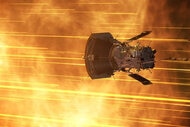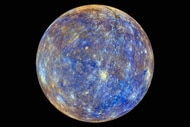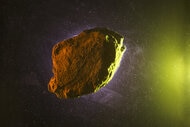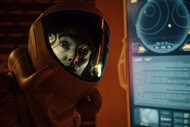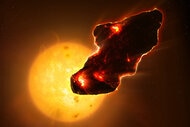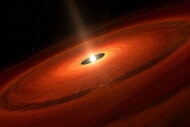Create a free profile to get unlimited access to exclusive videos, sweepstakes, and more!
How an Ancient Planetary Collision Carved Pluto's Heart-Shaped Face
Pluto's heart-shaped geological features are scars from a violent ancient past.

In 1980, football player Greg “Flash” Gordon took what was supposed to be an ordinary flight when his tiny aircraft was hit by a meteor. That tiny cosmic collision was the latest in a string of global disasters and it was only a taste of what was to come. After surviving a plane crash, Flash teams up with a NASA scientist and hops a rocket to the planet Mongo to stop aliens from pushing the Moon into the Earth.
Five decades earlier and in the real world, Clyde Tombaugh, an astronomer at Arizona’s Lowell Observatory discovered a tiny world at the edge of the solar system and called it Pluto. At the time, our view of the little planetoid was little more than a few pixels of undefined light. Later, the Hubble Space Telescope pointed toward Pluto and our view got a little clearer.
Not until NASA’s New Horizons spacecraft flew past Pluto in 2015 did we finally get to see its true face. That’s when we realized that Pluto is gorgeous, marked by a massive heart-shaped geological structure called Tombaugh Regio, named for Pluto’s discoverer. Now, astronomers suggest that Pluto’s heart was carved out by a catastrophic collision with another world. Flash Gordon was nowhere to be found.
For More on Pluto:
Pluto Is a Planet Again, but Only in Arizona
Pluto May Have Once Had Huge Cryovolcanic Ice Flows
The Face of Pluto is Slowly Changing and Now we Know Why
Astronomers Model Pluto's Violent Past and It's Heart-Shaped Surface
When New Horizons first sent back images of Pluto’s heart-covered face, they immediately captured the imaginations of the public and the attention of astronomers. Researchers from the University of Arizona and the University of Bern in Switzerland focused their attention on Sputnik Planitia, the western lobe of Tombaugh Regio, in the hope that it might reveal why Pluto wears its heart on its face.
They concluded that the heart was carved out by an incredible planetary collision, in a new study published in the journal Nature Astronomy. To figure out how Pluto may have ended up in its current form, they simulated planets crashing over and over again with slightly different conditions. They simulated Pluto and its crashing partner with different compositions and smashed them together at different velocities and angles. The goal was ending up with a Pluto featuring something similar to Sputnik Planitia and the wider Tombaugh Regio.
One of the features they were looking for was high reflectivity. Pluto’s heart is so stark because it reflects a lot more sunlight than the surrounding region. The result is a heart that sticks out from the background, or should we say foreground? Sputnik Planitia stretches 750 miles in one direction and 1,250 miles in the other, and it sits about 2.5 miles lower in elevation than the rest of the dwarf planet. It’s a geological gouge so deep you could stack two Grand Canyons inside of it and have room left over. Those qualities helped researchers dial in on the right scenarios to model. In the end, their simulations suggested Pluto was hit by a world about 400 miles across at an angle of about 30 degrees. The glancing blow, at relatively slow speed, and Pluto’s ability to take a punch, resulted in the heart-shaped structure we see today.
"Pluto's core is so cold that the rocks remained very hard and did not melt despite the heat of the impact, and thanks to the angle of impact and the low velocity, the core of the impactor did not sink into Pluto's core, but remained intact as a splat on it," said the lead author of the study, Harry Ballantyne in a statement.
It must have been a bad day for Pluto, but it worked out in the end; a few scars make a planet more interesting.
Save the world with Flash Gordon, available from Universal Pictures.

